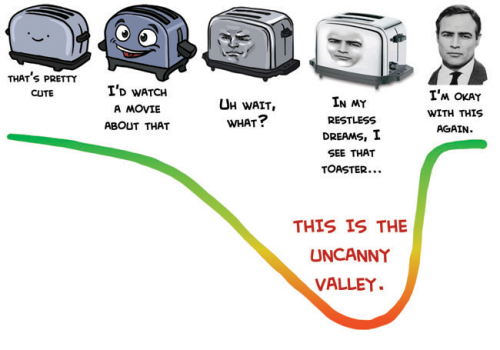What is the Uncanny Valley?
Conceived of by Japanese roboticist Masahiro Mori in 1970 to explain the psychological reaction to anthropomorphic robots, or more broadly, any human facsimile, the uncanny valley is a graph (below) that tracks human emotional responses to anthropomorphic machines or other humanoid figures.
 Mori found that humans react positively to robots that approach human-like appearance, but there is a point where we see a steep dropoff – i.e. a negative emotional response – when robots or other human facsimiles look too human, but still not quite right. This dropoff is called the uncanny valley, the point at which robots stop being cool and start giving us the creeps. Think about it for a moment. It really bears out in experience, or at least in the media.
Mori found that humans react positively to robots that approach human-like appearance, but there is a point where we see a steep dropoff – i.e. a negative emotional response – when robots or other human facsimiles look too human, but still not quite right. This dropoff is called the uncanny valley, the point at which robots stop being cool and start giving us the creeps. Think about it for a moment. It really bears out in experience, or at least in the media.
Mori uses the word “uncanny” based on Sigmund Freud’s elaboration on that concept in his essay “The Uncanny” (1919), which – among other things – attempts to explain the human aversion to dolls and the idea of mechanical beings. Or to put it more generally, “why we get creeped out by stuff.” He relates it to the “primitive” human tendency towards idol worship, taboos surrounding the dead, and the unconscious belief that inanimate things can come come to life.
His concept of the primitive is rather problematic, but his essay goes a long way in explaining the fascination with zombies, aliens, robots, and vampires in pop culture, for example. They are human-like, but not. We are both fascinated and horrified by beings that don’t easily fit into one category or other – dead / alive, human / machine, human / nonhuman, etc. Our brains are uncomfortable with this problem of categorization, and it gets more uncomfortable the further into the “valley” it descends.
My dissertation Die Mensch-Maschine: Technologies of Replication and Reproducation in German-Language Literature and Culture, 1770-2000 and a lot of my research since deals at least tangentially with the uncanny. I’ve even taught a course that examines the uncanny in literature, “Monsters, Madness, and Mechanical Men.” The uncanny also comes up a lot in reference to genre fiction and visual culture, so the concept relates to a lot of what I do here on this site. Occasionally I even mention the uncanny directly in my posts.
